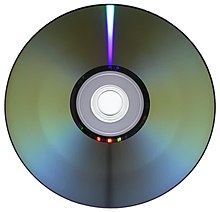
Back DVD Afrikaans DVD ALS دي في دي Arabic DVD AST DVD Azerbaijani DVD Byelorussian DVD BE-X-OLD DVD Bulgarian ডিভিডি Bengali/Bangla DVD BS
 | |
 The data side of a DVD manufactured by Sony DADC | |
| Media type | Optical disc |
|---|---|
| Encoding | DVD-ROM and DVD-R(W) use one encoding, DVD-RAM and DVD+R(W) uses another |
| Capacity | 4.7 GB (single-sided, single-layer – common) 8.5 GB (single-sided, double-layer) 9.4 GB (double-sided, single-layer) 17.08 GB (double-sided, double-layer) Up to four layers are possible in a standard form DVD. |
| Read mechanism | 650 nm laser, 10.5 Mbit/s (1×) |
| Write mechanism | 650 nm laser with a focused beam using more power than for reading, 10.5 Mbit/s (1×) |
| Standard | DVD Forum's DVD Books[1][2][3] and DVD+RW Alliance specifications |
| Developed by | Sony Panasonic Philips Toshiba |
| Dimensions | Diameter: 12 cm (4.7 in) Thickness: 1.2 mm (0.047 in) |
| Weight | 16 grams (0.56 oz) |
| Usage | Home video, Computer data storage |
| Extended from | LaserDisc Compact disc |
| Extended to | |
| Released | November 1, 1996 (Japan)[4] January 1997 (CIS and other Asia) March 24, 1997 (United States)[5][6][7] March 1998 (Europe)[8] February 1999 (Australia/New Zealand) |
| Optical discs |
|---|
The DVD (common abbreviation for digital video disc or digital versatile disc)[9][10] is a digital optical disc data storage format. It was invented and developed in 1995 and first released on November 1, 1996, in Japan. The medium can store any kind of digital data and has been widely used to store video programs (watched using DVD players), software and other computer files. DVDs offer significantly higher storage capacity than compact discs (CD) while having the same dimensions. A standard single-layer DVD can store up to 4.7 GB of data, a dual-layer DVD up to 8.5 GB. Variants can store up to a maximum of 17.08 GB.[11]
Prerecorded DVDs are mass-produced using molding machines that physically stamp data onto the DVD. Such discs are a form of DVD-ROM because data can only be read and not written or erased. Blank recordable DVD discs (DVD-R and DVD+R) can be recorded once using a DVD recorder and then function as a DVD-ROM. Rewritable DVDs (DVD-RW, DVD+RW, and DVD-RAM) can be recorded and erased many times.
DVDs are used in DVD-Video consumer digital video format and less commonly in DVD-Audio consumer digital audio format, as well as for authoring DVD discs written in a special AVCHD format to hold high definition material (often in conjunction with AVCHD format camcorders). DVDs containing other types of information may be referred to as DVD data discs.
- ^ Cite error: The named reference
dvd-bookwas invoked but never defined (see the help page). - ^ Cite error: The named reference
dvd-bookswas invoked but never defined (see the help page). - ^ Cite error: The named reference
dvd-books-overviewwas invoked but never defined (see the help page). - ^ Taylor, Jim (March 21, 1997). "DVD Frequently Asked Questions (with answers!)". Video Discovery. Archived from the original on March 29, 1997. Retrieved August 20, 2019.
- ^ Johnson, Lawrence B. (September 7, 1997). "For the DVD, Disney Magic May Be the Key". The New York Times. Archived from the original on July 29, 2018. Retrieved May 25, 2009.
- ^ Copeland, Jeff B. (March 23, 1997). "Oscar Day Is Also DVD Day". E! Online. Archived from the original on April 11, 1997. Retrieved August 21, 2019.
- ^ Staff (March 24, 1997). "Creative Does DVD". PC Gamer. Archived from the original on February 18, 1998. Retrieved December 5, 2019.
- ^ Andrews, Sam (March 28, 1998). "DVD Gets 'Soft Launch' In Britain" (PDF). Billboard. New York, NY. Retrieved November 26, 2023.
- ^ Popular Mechanics, June 1997, p. 69;
- ^ Jim Taylor, DVD demystified, McGraw Hill, 1998, 1st edition, p. 405
- ^ "CD/DVD comparison chart". h71036.www7.hp.com. Archived from the original on June 30, 2022. Retrieved January 26, 2022.